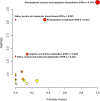Metabolomic signatures associated with fetal growth restriction and small for gestational age: a systematic review
- PMID: 39528475
- PMCID: PMC11555221
- DOI: 10.1038/s41467-024-53597-4
Metabolomic signatures associated with fetal growth restriction and small for gestational age: a systematic review
Abstract
The pathways involved in the pathophysiology of fetal growth restriction (FGR) and small for gestational age (SGA) are incompletely understood. We conduct a systematic review to identify metabolomic signatures in maternal and newborn tissues and body fluids samples associated with FGR/SGA. Here, we report that 825 non-duplicated metabolites were significantly altered across the 48 included studies using 10 different human biological samples, of which only 56 (17 amino acids, 12 acylcarnitines, 11 glycerophosphocholines, six fatty acids, two hydroxy acids, and eight other metabolites) were significantly and consistently up- or down-regulated in more than one study. Three amino acid metabolism-related pathways and one related with lipid metabolism are significantly associated with FGR and/or SGA: biosynthesis of unsaturated fatty acids in umbilical cord blood, and phenylalanine, tyrosine and tryptophan biosynthesis, valine, leucine and isoleucine biosynthesis, and phenylalanine metabolism in newborn dried blood spot. Significantly enriched metabolic pathways were not identified in the remaining biological samples. Whether these metabolites are in the causal pathways or are biomarkers of fetal nutritional deficiency needs to be explored in large, well-phenotyped cohorts.
© 2024. The Author(s).
Conflict of interest statement
Figures



References
-
- Villar, J. et al. International standards for newborn weight, length, and head circumference by gestational age and sex: the Newborn Cross-Sectional Study of the INTERGROWTH-21st Project. Lancet384, 857–868 (2014). - PubMed
-
- Villar, J. et al. INTERGROWTH-21 st very preterm size at birth reference charts. Lancet387, 844–845 (2016). - PubMed
-
- Lawn, J. E. et al. Small babies, big risks: global estimates of prevalence and mortality for vulnerable newborns to accelerate change and improve counting. Lancet401, 1707–1719 (2023). - PubMed
Publication types
MeSH terms
Substances
Grants and funding
LinkOut - more resources
Full Text Sources
Miscellaneous

